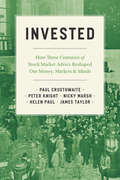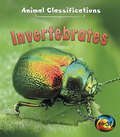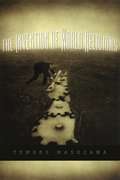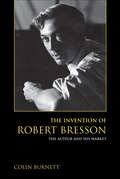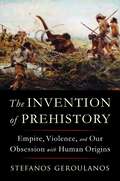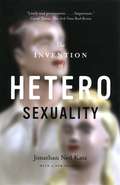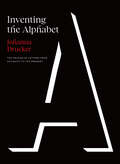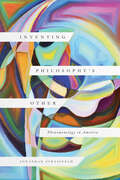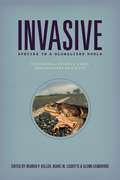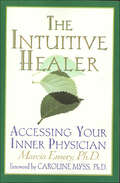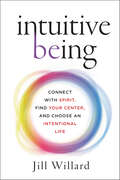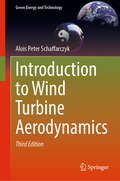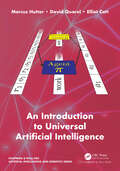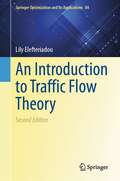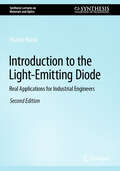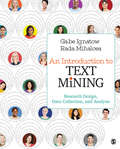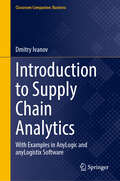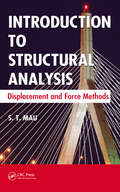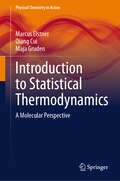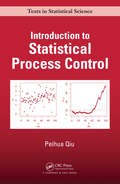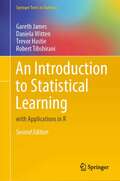- Table View
- List View
Investigating Social Problems
by A. Javier TrevinoGeneral Editor A. Javier Trevino, working with a panel of experts, thoroughly examines all aspects of social problems, providing a contemporary and authoritative introduction to the field. Each chapter is written by a specialist on that particular topic. This unique, contributed format ensures that the research, examples, and theories described are the most current and relevant available. The text is framed around three major themes: intersectionality (the interplay of race, ethnicity, class, and gender), the global scope of many problems, and how researchers take an evidence-based approach to studying problems.
Investigating Social Problems
by A. Javier TrevinoGeneral Editor A. Javier Trevino, working with a panel of experts, thoroughly examines all aspects of social problems, providing a contemporary and authoritative introduction to the field. Each chapter is written by a specialist on that particular topic. This unique, contributed format ensures that the research, examples, and theories described are the most current and relevant available. The text is framed around three major themes: intersectionality (the interplay of race, ethnicity, class, and gender), the global scope of many problems, and how researchers take an evidence-based approach to studying problems.
Investigating School Psychology: Pseudoscience, Fringe Science, and Controversies (Investigating Psychology Pseudoscience)
by Stephen Hupp Michael I. AxelrodInvestigating School Psychology provides a fascinating exploration of the field of school psychology through the lens of pseudoscience and fringe science. Contributions from leaders in the fields of school psychology, clinical psychology, and education honor the role of science in the field while also exploring and guarding against the harms that pseudoscience can cause.School psychology and, more broadly, the field of education are particularly susceptible to pseudoscience, fads, and maintaining the status quo by resisting the adoption of new ideas. Using an exhaustive review of the current literature, this book discusses various concepts in school psychology that have been largely discredited and many practices that continue to exist with little to no scientific support. Each chapter helps differentiate between dubious and evidence-based approaches while providing a useful resource for practicing school psychologists and educators to distinguish between science and pseudoscience in their everyday work with children. The book’s discussion of the harmful nature of pseudoscience in school psychology is inclusive of all students, such as students with disabilities, those diagnosed with neurodevelopmental disorders, those with academic problems, and all other children in schools.Investigating School Psychology is valuable supplemental reading in undergraduate and graduate courses in education and school psychology and is also a beneficial reference for practicing school psychologists to distinguish between science and pseudoscience in their practice.
Invested: How Three Centuries of Stock Market Advice Reshaped Our Money, Markets, and Minds
by Peter Knight Nicky Marsh Paul Crosthwaite Helen PaulInvested examines the perennial and nefarious appeal of financial advice manuals. Who hasn’t wished for a surefire formula for riches and a ticket to the good life? For three centuries, investment advisers of all kinds, legit and otherwise, have guaranteed that they alone can illuminate the golden pathway to prosperity—despite strong evidence to the contrary. In fact, too often, they are singing a siren song of devastation. And yet we keep listening. Invested tells the story of how the genre of investment advice developed and grew in the United Kingdom and the United States, from its origins in the eighteenth century through today, as it saturates our world. The authors analyze centuries of books, TV shows, blogs, and more, all promising techniques for amateur investors to master the ways of the market: from Thomas Mortimer’s pathbreaking 1761 work, Every Man His Own Broker, through the Gilded Age explosion of sensationalist investment manuals, the early twentieth-century emergence of a vernacular financial science, and the more recent convergence of self-help and personal finance. Invested asks why, in the absence of evidence that such advice reliably works, guides to the stock market have remained perennially popular. The authors argue that the appeal of popular investment advice lies in its promise to level the playing field, giving outsiders the privileged information of insiders. As Invested persuasively shows, the fantasies sold by these writings are damaging and deceptive, peddling unrealistic visions of easy profits and the certainty of success, while trying to hide the fact that there is no formula for avoiding life’s economic uncertainties and calamities.
Invertebrates (Animal Classifications Ser.)
by Angela RoystonThis fascinating series takes a very simple look at animal classifications, with each book focussing on a different group of animal. This book is about invertebrates: what they do, how they behave, and how these characteristics are different from other groups of animals. Beautifully illustrated with colorful photographs, the book shows many examples of different types of invertebrates in their natural environment.
The Invention of World Religions
by Tomoko MasuzawaThe idea of "world religions" expresses a vague commitment to multiculturalism. Not merely a descriptive concept, "world religions" is actually a particular ethos, a pluralist ideology, a logic of classification, and a form of knowledge that has shaped the study of religion and infiltrated ordinary language. In this ambitious study, Tomoko Masuzawa examines the emergence of "world religions" in modern European thought. Devoting particular attention to the relation between the comparative study of language and the nascent science of religion, she demonstrates how new classifications of language and race caused Buddhism and Islam to gain special significance, as these religions came to be seen in opposing terms-Aryan on one hand and Semitic on the other. Masuzawa also explores the complex relation of "world religions" to Protestant theology, from the hierarchical ordering of religions typical of the Christian supremacists of the nineteenth century to the aspirations of early twentieth-century theologian Ernst Troeltsch, who embraced the pluralist logic of "world religions" and by so doing sought to reclaim the universalist destiny of European modernity.
The Invention of Robert Bresson: The Auteur and His Market
by Colin BurnettChallenging the prevailing notion among cinephiles that the auteur is an isolated genius interested primarily in individualism, Colin Burnett positions Robert Bresson as one whose life's work confronts the cultural forces that helped shape it. Regarded as one of film history's most elusive figures, Bresson (1901–1999) carried himself as an auteur long before cultural magazines, like the famed Cahiers du cinéma, advanced the term to describe such directors as Jacques Tati, Alfred Hitchcock, and Jean-Luc Godard. In this groundbreaking study, Burnett combines biography with cultural history to uncover the roots of the auteur in the alternative cultural marketplace of midcentury France.
The Invention of Prehistory: Empire, Violence, And Our Obsession With Human Origins
by Stefanos Geroulanos“[A]n incisive and captivating reassessment of prehistory . . . In lucid prose, Geroulanos unspools an enthralling and detailed history of the development of modern natural science. It’s a must-read.” —Publishers Weekly, starred review “An astute, powerfully rendered history of humanity.” —Kirkus Reviews, starred review An eminent historian tells the story of how we came to obsess over the origins of humanity—and how, for three centuries, ideas of prehistory have been used to justify devastating violence against others. Books about the origins of humanity dominate bestseller lists, while national newspapers present breathless accounts of new archaeological findings and speculate about what those findings tell us about our earliest ancestors. We are obsessed with prehistory—and, in this respect, our current era is no different from any other in the last three hundred years. In this coruscating work, acclaimed historian Stefanos Geroulanos demonstrates how claims about the earliest humans not only shaped Western intellectual culture, but gave rise to our modern world. The very idea that there was a human past before recorded history only emerged with the Enlightenment, when European thinkers began to reject faith-based notions of humanity and history in favor of supposedly more empirical ideas about the world. From the “state of nature” and Romantic notions of virtuous German barbarians to theories about Neanderthals, killer apes, and a matriarchal paradise where women ruled, Geroulanos captures the sheer variety and strangeness of the ideas that animated many of the major thinkers of the eighteenth and nineteenth centuries, including Jean-Jacques Rousseau, Charles Darwin, and Karl Marx. Yet as Geroulanos shows, such ideas became, for the most part, the ideological foundations of repressive regimes and globe-spanning empires. Deeming other peoples “savages” allowed for guilt-free violence against them; notions of “killer apes” who were our evolutionary predecessors made war seem natural. The emergence of modern science only accelerated the West’s imperialism. The Nazi obsession with race was rooted in archaeological claims about prehistoric IndoGermans; the idea that colonialized peoples could be “bombed back to the Stone Age” was made possible by the technology of flight and the anthropological idea that civilization advanced in stages. As Geroulanos argues, accounts of prehistory tell us more about the moment when they are proposed than about the deep past—and if we hope to start improving our future, we would be better off setting aside the search for how it all started. A necessary, timely, indelible account of how the quest for understanding the origins of humanity became the handmaiden of war and empire, The Invention of Prehistory will forever change how we think about the deep past.
The Invention of Heterosexuality
by Jonathan Ned Katz“Heterosexuality,” assumed to denote a universal sexual and cultural norm, has been largely exempt from critical scrutiny. In this boldly original work, Jonathan Ned Katz challenges the common notion that the distinction between heterosexuality and homosexuality has been a timeless one. Building on the history of medical terminology, he reveals that as late as 1923, the term “heterosexuality” referred to a "morbid sexual passion," and that its current usage emerged to legitimate men and women having sex for pleasure. Drawing on the works of Sigmund Freud, James Baldwin, Betty Friedan, and Michel Foucault, The Invention of Heterosexuality considers the effects of heterosexuality’s recently forged primacy on both scientific literature and popular culture. “Lively and provocative.”—Carol Tavris, New York Times Book Review “A valuable primer . . . misses no significant twists in sexual politics.”—Gary Indiana, Village Voice Literary Supplement “One of the most important—if not outright subversive—works to emerge from gay and lesbian studies in years.”—Mark Thompson, The Advocate
Inventing the Alphabet: The Origins of Letters from Antiquity to the Present
by Johanna DruckerThe first comprehensive intellectual history of alphabet studies.Inventing the Alphabet provides the first account of two-and-a-half millennia of scholarship on the alphabet. Drawing on decades of research, Johanna Drucker dives into sometimes obscure and esoteric references, dispelling myths and identifying a pantheon of little-known scholars who contributed to our modern understandings of the alphabet, one of the most important inventions in human history. Beginning with Biblical tales and accounts from antiquity, Drucker traces the transmission of ancient Greek thinking about the alphabet’s origin and debates about how Moses learned to read. The book moves through the centuries, finishing with contemporary concepts of the letters in alpha-numeric code used for global communication systems. Along the way, we learn about magical and angelic alphabets, antique inscriptions on coins and artifacts, and the comparative tables of scripts that continue through the development of modern fields of archaeology and paleography. This is the first book to chronicle the story of the intellectual history through which the alphabet has been “invented” as an object of scholarship.
Inventing Philosophy's Other: Phenomenology in America
by Jonathan StrassfeldThe history of phenomenology, and its absence, in American philosophy. Phenomenology and so-called “continental philosophy” receive scant attention in most American philosophy departments, despite their foundational influence on intellectual movements such as existentialism, post-structuralism, and deconstruction. In Inventing Philosophy’s Other, Jonathan Strassfeld explores this absence, revealing how everyday institutional practices played a determinative role in the development of twentieth-century academic discourse. Conventional wisdom holds that phenomenology’s absence from the philosophical mainstream in the United States reflects its obscurity or even irrelevance to America’s philosophical traditions. Strassfeld refutes this story as he traces phenomenology’s reception in America, delivering the first systematic historical study of the movement in the United States. He examines the lives and works of Marjorie Grene, Alfred Schütz, Hubert Dreyfus, and Iris Marion Young, among others, while also providing a fresh introduction to phenomenological philosophy.
Invasive Species in a Globalized World: Ecological, Social, & Legal Perspectives on Policy
by Reuben P. Keller, Marc W. Cadotte, Glenn SandifordOver the past several decades, the field of invasion biology has rapidly expanded as global trade and the spread of human populations have increasingly carried animal and plant species across natural barriers that have kept them ecologically separated for millions of years. Because some of these nonnative species thrive in their new homes and harm environments, economies, and human health, the prevention and management of invasive species has become a major policy goal from local to international levels. Yet even though ecological research has led to public conversation and policy recommendations, those recommendations have frequently been ignored, and the efforts to counter invasive species have been largely unsuccessful. Recognizing the need to engage experts across the life, social, and legal sciences as well as the humanities, the editors of this volume have drawn together a wide variety of ecologists, historians, economists, legal scholars, policy makers, and communications scholars, to facilitate a dialogue among these disciplines and understand fully the invasive species phenomenon. Aided by case studies of well-known invasives such as the cane toad of Australia and the emerald ash borer, Asian carp, and sea lampreys that threaten US ecosystems, Invasive Species in a Globalized World offers strategies for developing and implementing anti-invasive policies designed to stop their introduction and spread, and to limit their effects.
The Intuitive Healer: Accessing Your Inner Physician
by Marcia EmeryThe doctor is within.Do you believe that you are doing everything you can to help yourself heal? Do you listen to your body, heeding its messages on health-- or disease? So you honor your hunches when something just doesn't feel right? Would you like to learn how?In The Intuitive Healer, renowned intuition expert, Dr. Marcia Emery shows readers how to unlock their inner powers of health and healing by harnessing the wisdom of their intuition. Learn how to:* Discover the deeper meaning of any ailment* Know what steps to take to address the causes of disease and begin the process of healing* "Tune in" to any ailing body part to help healing take place* Hear the intuitive healer speak through dreamsThrough inspirational anecdotes and step-by-step exercises, Dr. Emery will show you how to call on your own "inner physician" for a dose of prevention or a cure for what ails you. The Intuitive Healer will empower you to take your health into your own hands, placing you on the road to lasting wellness.
Intuitive Being: Connect with Spirit, Find Your Center, and Choose an Intentional Life
by Jill Willard“Intuitive Being shows us how to unlock the power of our intuition to make better decisions and live a more satisfying life.” —Deepak Chopra, author of Super GenesOne of GOOP's Fall '16 Nonfiction Top PicksWe all possess an intuition far more powerful than we realize. Discover how to unlock its incredible wisdom with Intuitive Being.Beloved by celebrities and CEOs alike, intuitive medium Jill Willard's revolutionary approach to honing and tapping into the profound potential of your intuition teaches readers:How our inner voice is fundamentally connected to spiritHow to unleash the power and wisdom of intuition through unblocking and balancing each of the seven energy centers within ourselves--the gateways that connect our inner being to spiritHow that connection is at the heart of intuitionHow to use that connection for better decision-making and informed choices that lead to unlimited growth and ultimate abundance in every area of our lives"Jill Willard... guided us through tapping into and translating gut instinct greater knowing."—GOOP
Introduction to Wind Turbine Aerodynamics (Green Energy and Technology)
by Alois Peter SchaffarczykThis book is an introduction to wind turbine aerodynamics for professionals and students with a diverse range of backgrounds. It is a self-contained textbook that shows how to progress from the basics of fluid mechanics to modern wind turbine blade design. It presents the fundamentals of fluid dynamics and inflow conditions, as well as extensive information on theories describing the aerodynamics of wind turbines. After examining a number of related experiments, the book applies the lessons learned to blade design.The text of this 3rd edition has been thoroughly revised, and the book includes a new section on aerodynamic design and optimization.
An Introduction to Universal Artificial Intelligence (Chapman & Hall/CRC Artificial Intelligence and Robotics Series)
by Marcus Hutter David Quarel Elliot CattAn Introduction to Universal Artificial Intelligence provides the formal underpinning of what it means for an agent to act intelligently in an unknown environment. First presented in Universal Algorithmic Intelligence (Hutter, 2000), UAI offers a framework in which virtually all AI problems can be formulated, and a theory of how to solve them. UAI unifies ideas from sequential decision theory, Bayesian inference, and algorithmic information theory to construct AIXI, an optimal reinforcement learning agent that learns to act optimally in unknown environments. AIXI is the theoretical gold standard for intelligent behavior.The book covers both the theoretical and practical aspects of UAI. Bayesian updating can be done efficiently with context tree weighting, and planning can be approximated by sampling with Monte Carlo tree search. It provides algorithms for the reader to implement, and experimental results to compare against. These algorithms are used to approximate AIXI. The book ends with a philosophical discussion of Artificial General Intelligence: Can super-intelligent agents even be constructed? Is it inevitable that they will be constructed, and what are the potential consequences?This text is suitable for late undergraduate students. It provides an extensive chapter to fill in the required mathematics, probability, information, and computability theory background.
An Introduction to Traffic Flow Theory (Springer Optimization and Its Applications #84)
by Lily ElefteriadouThis second edition of An Introduction to Traffic Flow Theory adds new material in several chapters related to advanced technologies including autonomy, the use of sensors and communications, and particularly congestion mitigation solutions that leverage connected and autonomous vehicles (CAVs). It also includes a new chapter that briefly outlines several mathematical analysis techniques commonly used in traffic flow theory, aiming to introduce students to some of the most frequently used tools available for traffic operational-related analysis. This new edition also includes several updates related to the most recent versions of the Highway Capacity Manual and the Green Book. This textbook is meant for use in advanced undergraduate/graduate level courses in traffic flow theory with prerequisites including two semesters of calculus, statistics, and an introductory course in transportation. The text would also be of interest to transportation professionals as a refresherin traffic flow theory or as a reference. Students and engineers of diverse backgrounds will find this text accessible and applicable to today’s traffic issues.This text provides a comprehensive and concise treatment of the topic of traffic flow theory and includes several topics relevant to today’s highway transportation system. It provides the fundamental principles of traffic flow theory as well as applications of those principles for evaluating specific types of facilities (freeways, intersections, etc.). Newer concepts of Intelligent transportation systems (ITS) and their potential impact on traffic flow are discussed. State-of-the-art traffic flow research, microscopic traffic analysis, and traffic simulation have significantly advanced and are also discussed in this text. Real-world examples and useful problem sets complement each chapter.
Introduction to the Light-Emitting Diode: Real Applications for Industrial Engineers (Synthesis Lectures on Materials and Optics)
by Hisashi MasuiThis book covers the industrial aspects of light-emitting diodes (LEDs) for solid-state lighting (SSL). The author targets his approach primarily to industrial engineers, in order to guide them in the LED industry. The coverage is highly-applied and based on author’s 32 years of experience in the LED industry and academia. The book starts by addressing the needs that new engineers encounter in an LED company, e.g., characterization, manufacturing, and applications. Later chapters introduce deeper science for more experienced engineers and academic readers. As a result, this book can benefit LED engineers throughout their career.
An Introduction to Text Mining: Research Design, Data Collection, and Analysis
by Gabe Ignatow Rada F. MihalceaThis is the ideal introduction for students seeking to collect and analyze textual data from online sources. It covers the most critical issues that they must take into consideration at all stages of their research projects.
An Introduction to Text Mining: Research Design, Data Collection, and Analysis
by Gabe Ignatow Rada F. MihalceaThis is the ideal introduction for students seeking to collect and analyze textual data from online sources. It covers the most critical issues that they must take into consideration at all stages of their research projects.
Introduction to Supply Chain Analytics: With Examples in AnyLogic and anyLogistix Software (Classroom Companion: Business)
by Dmitry IvanovThe book offers a concise yet comprehensive introduction to supply chain analytics covering management, modeling, and technology perspectives. Designed to accompany the textbook “Global Supply Chain and Operations Management”, it addresses the topics of supply chain analytics in more depth. The book describes descriptive, predictive, and prescriptive supply chain analytics explaining methodologies, illustrating method applications with the use of training exercises, and providing numerous examples in AnyLogic and anyLogistix software. Throughout the book, numerous practical examples and short case studies are given to illustrate theoretical concepts. Along with AnyLogic and anyLogistix model development guidelines and examples, the book has two other distinct features. First, it reviews and explains novel frameworks and concepts related to data-driven decision-making and digital twins. Second, it shows how to use analytics to improve supply chain resilience.Without relying heavily on mathematical derivations, the book offers a structured presentation and explanation of major supply chain analytics techniques and principles in a simple, predictable format to make it easy to understand for students and professionals with both management and engineering backgrounds. Graduate/Ph.D. students and supply chain professionals alike would benefit from a structured and didactically-oriented concise presentation of the concepts, principles, and methods of supply chain analytics. Providing graduate students and supply chain managers with working knowledge of basic and advanced supply chain analytics, this book contributes to improving knowledge-awareness of decision-making in increasingly data-driven and digital environments. The book is supplemented by a companion website offering interactive exercises with the use of AnyLogic and anyLogistix software as well as Spreadsheet Modeling.
Introduction to Structural Analysis: Displacement and Force Methods
by S. T. MauBridging the gap between what is traditionally taught in textbooks and what is actually practiced in engineering firms, Introduction to Structural Analysis: Displacement and Force Methods clearly explains the two fundamental methods of structural analysis: the displacement method and the force method. It also shows how these methods are applied, pa
Introduction to Statistical Thermodynamics: A Molecular Perspective (Physical Chemistry in Action)
by Qiang Cui Marcus Elstner Maja GrudenThis textbook presents the fundamentals of statistical thermodynamics and electronic structure theory and focuses on introducing the central concepts of thermodynamics and their relation to microscopic theories in a conceptually clear and simple way. The emphasis is on the description of what is going on at the microscopic level, which allows readers to understand the various facets of entropy as the fundamental driving force of all material behaviors. An atomistic perspective is introduced from the beginning, highlighting the importance of molecular structure and microscopic degrees of freedom for understanding the thermodynamic properties of materials, such as heat capacity and magnetization. Because of their importance in various research fields, classical and quantum aspects are treated equally, allowing modern research topics to be addressed with molecular simulation and electronic structure theory. It is a valuable resource for undergraduate and graduate students in chemistry,physics, and materials science, and its modular structure makes it suitable for any reader.
Introduction to Statistical Process Control (Chapman & Hall/CRC Texts in Statistical Science)
by Peihua QiuA major tool for quality control and management, statistical process control (SPC) monitors sequential processes, such as production lines and Internet traffic, to ensure that they work stably and satisfactorily. Along with covering traditional methods, Introduction to Statistical Process Control describes many recent SPC methods that improve upon
An Introduction To Statistical Learning: With Applications In R (Springer Texts In Statistics Ser.)
by Trevor Hastie Gareth James Robert Tibshirani Daniela WittenAn Introduction to Statistical Learning provides an accessible overview of the field of statistical learning, an essential toolset for making sense of the vast and complex data sets that have emerged in fields ranging from biology to finance to marketing to astrophysics in the past twenty years. This book presents some of the most important modeling and prediction techniques, along with relevant applications. Topics include linear regression, classification, resampling methods, shrinkage approaches, tree-based methods, support vector machines, clustering, deep learning, survival analysis, multiple testing, and more. Color graphics and real-world examples are used to illustrate the methods presented. Since the goal of this textbook is to facilitate the use of these statistical learning techniques by practitioners in science, industry, and other fields, each chapter contains a tutorial on implementing the analyses and methods presented in R, an extremely popular open source statistical software platform. Two of the authors co-wrote The Elements of Statistical Learning (Hastie, Tibshirani and Friedman, 2nd edition 2009), a popular reference book for statistics and machine learning researchers. An Introduction to Statistical Learning covers many of the same topics, but at a level accessible to a much broader audience. This book is targeted at statisticians and non-statisticians alike who wish to use cutting-edge statistical learning techniques to analyze their data. The text assumes only a previous course in linear regression and no knowledge of matrix algebra. This Second Edition features new chapters on deep learning, survival analysis, and multiple testing, as well as expanded treatments of naïve Bayes, generalized linear models, Bayesian additive regression trees, and matrix completion. R code has been updated throughout to ensure compatibility.
